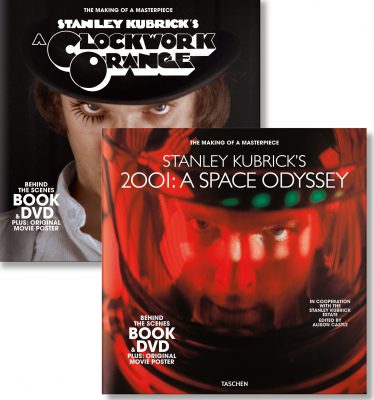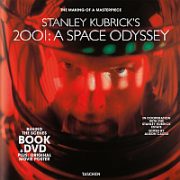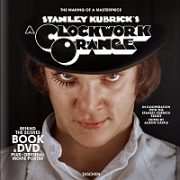Two new books in Taschen‘s Making of a Masterpiece series go into detail on Stanley Kubrick‘s A Clockwork Orange and 2001: A Space Odyssey.
 Edited by Alison Castle, who has published books on film, design and photography for many years in an excellent manner, the beautiful and richly pictured editions reveal many facts and maybe some secrets about the films that easily rank among the best movies of their decades.
Edited by Alison Castle, who has published books on film, design and photography for many years in an excellent manner, the beautiful and richly pictured editions reveal many facts and maybe some secrets about the films that easily rank among the best movies of their decades.
When in 1964 exceptional British director Stanley Kubrick (1928 – 1999) got in touch with prominent science-fiction writer Arthur C. Clarke to cooperate on a film project, neither of them would have imagined the success of the finished movie.
Loosely based on a Clarke story about the detection of a xenofact on the moon, the film would both reveal the possible origins and future of mankind and the slow discovery of alien life, meanwhile dealing with defective technology and other obstacles.
 The resulting epic movie that premiered in 1968, one year before the lunar landing, was filmed in Super Panavision and the psychedelic blurred effects, splashing color explosions and shots of space made the movie a fully mind-expanding experience, best watched on a large screen (and loyal fans tell of seeing the film many dozen times).
The resulting epic movie that premiered in 1968, one year before the lunar landing, was filmed in Super Panavision and the psychedelic blurred effects, splashing color explosions and shots of space made the movie a fully mind-expanding experience, best watched on a large screen (and loyal fans tell of seeing the film many dozen times).
In 1965, when the project began to take shape, an army of set decorators, tailors and fashion designers began to manufacture what then would look like uniforms, space suits, and apparel that would be available some 40 years later, in fact, with such detail, that NASA altered the equipment specifications for the Apollo 11 mission.

Filmed long before digital effects became standard, an incredible amount of time and money went into special effects that were done “manually” and filmed in stop-motion and double exposure for days.
 The film became a success, particularly with young audiences, familiar with science fiction and very open minded; older audiences (and critics) obviously failed to understand it.
The film became a success, particularly with young audiences, familiar with science fiction and very open minded; older audiences (and critics) obviously failed to understand it.
Even though the emphasis of the book here is on visual impressions, there are shorter texts in this edition by Gene D. Phillips, Margaret Stackhouse, Carolyn Geduld, Anthony Frewin, and Herb A. Lightman that explain many technical issues, such as the filming of space station models and the centrifuge (costs: $750,000) scenes, international reception, philosophical conclusions and production obstructions of any kind.
 Kubrick’s next masterpiece A Clockwork Orange from 1971 was also way ahead of its time and the story of violent gang leader Alex, played by Malcolm McDowell, who undergoes new and experimental (equally violent) treatment to cure him from his murderous obsessions was generally well received by critics and audiences.
Kubrick’s next masterpiece A Clockwork Orange from 1971 was also way ahead of its time and the story of violent gang leader Alex, played by Malcolm McDowell, who undergoes new and experimental (equally violent) treatment to cure him from his murderous obsessions was generally well received by critics and audiences. 
In fact, due to the extreme ferocity of certain scenes, the movie was only shortly circulated in English cinemas, a decision going back to Kubrick himself. The film was merely available from its premier year (1972) until 1974. Only from March 2000 was it back in theaters.
A Clockwork Orange, based on the dystopian novel by author Anthony Burgess, was turned into a bombastic spectacle of Moog synthesizer audio, nightmarish bursts of savage violence, gang rituals, avant-garde fashion and design shows.
 It also transported biting parody and sarcasm and voiced heavy social criticism (making it one of Fellini’s and Bunuel’s favorite titles).
It also transported biting parody and sarcasm and voiced heavy social criticism (making it one of Fellini’s and Bunuel’s favorite titles).
Even though the film was nominated for an Oscar, it never won a prize in 1972, but for decades was the source of controversy and became a landmark in terms of set design, dialogue, choreography, and sound editing.
Together with the director’s Dr. Strangelove (1964) and 2001: A Space Odyssey, A Clockwork Orange is generally viewed as the last part of his visionary futuristic trilogy. It strongly inspired what soon was to become the American New Cinema and film d’auteur.
Each book edition features hundreds of screenplay drafts, film stills, behind-the-scenes photographs, and exclusive (sometimes never before published) material from the Stanley Kubrick estate archives. Furthermore, many details, surprising data and richly documented sources on the many steps that lead to the making of the masterpieces, interviews with Stanley Kubrick, and an illustrated biography and filmography are included.
Even though not the first publications on Kubrick or the individual films, here are two concise and yet detailed works that will find many friends, thanks to the print quality and the two little extras, as each 96 pages book (square LP-size) contains the original film poster and the remastered gem on DVD.
Review by Dr. A. Ebert © 2020
Alison Castle (ed.) Stanley Kubrick’s 2001: A Space Odyssey. Book & DVD Set (Making of a Masterpiece series), Taschen 2019, 96 p., ISBN 978-3-8365-7724-3
Alison Castle (ed.) Stanley Kubrick’s A Clockwork Orange. Book & DVD Set (Making of a Masterpiece series), Taschen 2019, 96 p., ISBN 978-3-8365-7726-7

